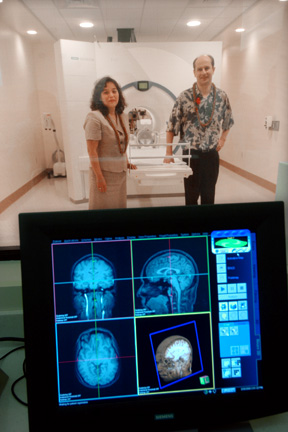
|
Mapping the brain
Researchers will use a new system
at Queen’s to study drugs’ effects
on the brain
A $3 million brain-imaging tool, a $2 million facility and two internationally renowned researchers offer hope of new solutions to substance abuse in Hawaii.
The Queen's Medical Center and the University of Hawaii John A. Burns School of Medicine have brought researchers Drs. Linda Chang and Thomas Ernst here from Brookhaven Laboratories in New York to use the only 3 Tesla Magnetic Resonance Imaging system in Hawaii for research on how drug abuse affects the brain.
The Office of National Drug Control Policy provided funding for the high-resolution MRI system, and Queen's contributed $2 million to develop a home for it in the hospital.
Dr. William Haning, chief of the Addiction Psychiatry Program and associate dean of graduate affairs and faculty development at the medical school, said the images will enable researchers to see how the brain responds to different treatments and identify drugs that are not appropriate during the recovery process.
Twice as powerful and faster than standard MRI machines used for patient imaging, it will also be used for HIV and aging research and some clinical diagnoses.
In a dedication and blessing ceremony yesterday, Arthur Ushijima, Queen's president and chief executive, said the cost of substance abuse amounts to "countless billions" across the country.
"At times I think we're fighting a war with muskets when we need laser-guided missiles," he said.
Officials hope that the 3 Tesla MRI provides those missiles.
"In a short time it has revolutionized the study of drug addiction," said Joseph Frascella, director of the Division of Clinical Neuroscience, Development and Behavioral Treatment at the National Institute of Drug Abuse.
Chang and Ernst are married and were recruited as professors in the UH medical school. Chang is clinical director and Ernst is technical director of the new research center.
Satoru Izutsu, senior associate dean of the school, said the two "are a perfect example of the faculty we need to move JABSOM into one of the top 50 medical schools in the country."
Ernst showed images of brain scans with the new MRI, saying, "The detail is exquisite."
He said researchers can look at the chemistry, physiology and functions of the brain, as well as other organs, and they can see how the brain functions when performing different activities.
"You can really watch someone think with this technique," Ernst said, showing changes in a brain scan as he played music.
Chang said the MRI will be used about 10 percent of the time to diagnose medical problems and the rest of the time for research, looking at how crystal methamphetamine and marijuana change chemicals in the brain.
"It's a tremendously powerful scanner which will help in developing improved prevention and treatment options for the community of Hawaii," she said.
[News] [Business] [Features] [Sports] [Editorial] [Do It Electric!]
[Classified Ads] [Search] [Subscribe] [Info] [Letter to Editor]
[Feedback]
